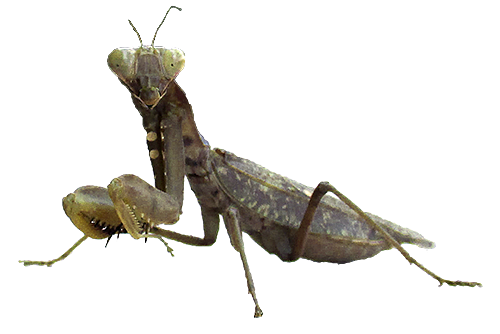
1.
O'Smach
The little town of O'Smach is a Cambodian border town to Thailand in the Dangrek Mountains. Pronounce it as if you would spit out a dirty bone. The border here is open since 2003, and after the construction of an asphalt road in the last years, two grand casinos shot out of the ground for gambling hungry Thai citizens.

O'Smach on route 68. Image by Asienreisender, 12/2015
The land- scapes here form a pass into the Dangrek Mountains and make an easy connection between the lower plains of Cambodia to the Khorat Plateau in Thailand (see: 'Isan'). The pass is since ancient times part of a travelling route between the both regions.
O'Smach (also spelled as Ou Smach or O Smach) consists of not much more than a few buildings stretching along national highway 68 (NH68). All the small sideroads are dirt roads except one, about a kilometer behind the border, which leads into the core of the place. That's one of these common filthy places in Cambodia; after a few hundred meters the pavement of the road ends and continues as a dirt road. All the side roads are also dirt roads, and there are not many buildings along them. In fact, O'Smach is merely a village. According to the border stones at NH68 the place's center is the border.
O'Smach Center
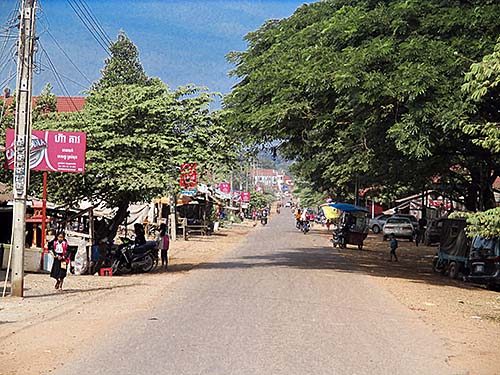
The village center with the only paved road, which is merely 400m long. Image by Asienreisender, 12/2015
The improvement of road 68 between O'Smach and the provincial capital Samraong was financed by a loan from Thailand, as practically always infrastructural projects here are financed by foreign investors. Seems, the Cambodians never pay the bills for their infrastructure. The poor can't, and the Khmer Rich don't want. The road was built then after 2008. The benefit for Thailand is, however, to create a new market here to sell farm equipment like the small tractors (iron buffalos) and a lot of household and entertainment equipment. There is also a lot of construction material coming from Thailand, for O'Smach, as all Cambodian places, needs urgently improvement.
NH68 is a four-lane highway, with two lanes each side. In the middle is an elevated stripe with neglected grass growing on it. That makes it impossible for vehicles entering the road from the 'wrong' side to drive in their direction on the right side, without making a detour of a kilometer or so to the next u-turn. The locals then, of course, drive on the wrong roadside. One of many examples where infrastructure is brushing the people's needs against the hair. For the needs of pedestrians, cyclists or kids is not cared at all. It's a dangerous road, particularly in regard of the Khmers driving skills.
The Thai counterpart of O'Smach is Chong Chom, about 1,500m behind the border in Surin Province, Thailand. Chong Chom is mostly a large market, stretching along the road to Surin city. Thai imports are mostly cassava.
The Border Casinos
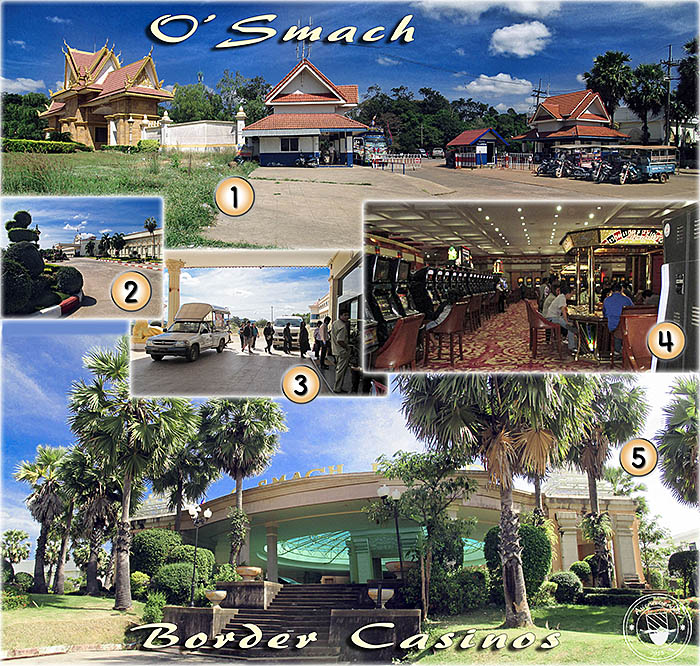
Gambling is a passion all over Southeast Asia. The promise of the quick and easy money tempts people to risk their savings, income, house and real-estate or they take a loan to make a fortune. At any Thai/Cambodian border are casinos on the Cambodian side.
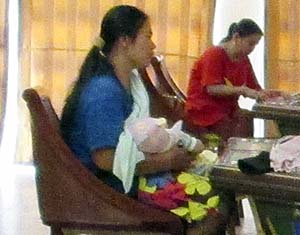
A Thai woman with her baby at the casino table. Image by Asienreisender, 1/2016
Gambling is forbidden in Thailand, so, apart from illegal gambling Thai People have to go abroad for trying their luck. For Cambodians it's also not allowed to gamble here, only for foreigners.
In January 2016, when I approached the border at Chong Chom, I was surprised to see hundreds of Thai People blocking the checkpoint for gaining a border pass, heading into the two casinos. Many Thai ordinary Thai women were among them - a caravan of housewives.
The Cambodian/Thai border (1). The Cambodian custom houses (right) are neighboured by a gate which looks as it would lead to a buddhist temple. In fact it leads to the Royal Hill Hotel & Casino (2) on Cambodian soil. Who leaves Thailand has to register at the Thai authorities but does not pass through the Cambodian control. He/she passes directly to the casino. In fact whole bus loads of gambling tourists are carried to the casino (3). What I saw inside the gambling hall (4) seemed to be mostly lower-class Thais. On the other side of the road lies O'Smach Resort & Casino (5). Rooms are available in both places and give a bad value for the money.
The border is open for people and trucks, but not for private cars. In the past it was, but most of the Thai cars who came to Cambodia were sold here and to stop that, the authorities closed the border for it.
Images and photocomposition by Asienreisender, 12/2015
Since O'Smach is a border place, there is much import-export activity here. Much of it will be smuggling, as always in such places. There are several guesthouses in the village for the various business men who come here frequently; Western tourists don't stay here. For them it's just a checkpoint and a change of transport to head further south to mostly Siem Reap, visiting Angkor Archaeological Park. They get often ripped off here by the transport mafia, because transport in Cambodia is not well organized. Not at all.
There are also no Westerners living in the place. No farang community here.
On the other hand do many Khmer travel to Surin Province for medical reasons. Not only the transport system in Cambodia is a mess, everything is a mess, including the medical system. Finding a more reasonable doctor and not merely a weird shaman, many Khmer look for help in neighbouring Thailand. A border pass for a Cambodian national is emitted at the border for 10,000 Riel (2.50 euro). Surin's population is, by the way, by 70% of Khmer descent, and Khmer language is still widely spoken.
People of O'Smach
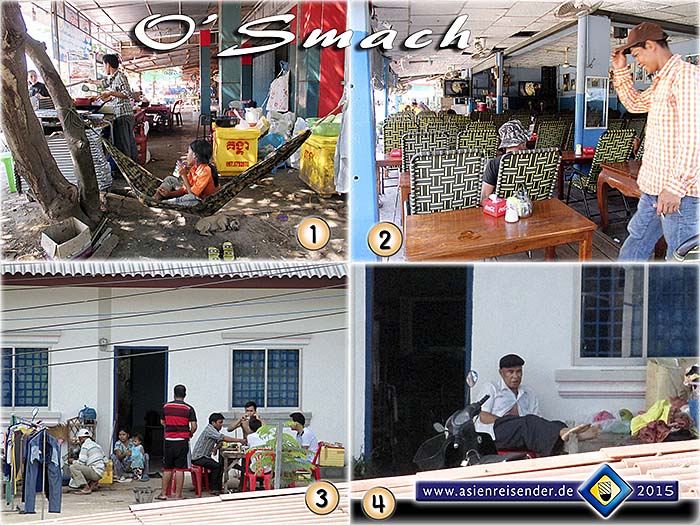
Village life. A restaurant (1). The owner worked for ten years in the tourist industries in Thailand and speaks fluent Thai and English. Khmers who lived for years abroad are significant different than the majority of the locals, who never left their country and have a very limited view on things.
A TV restaurant (2). That's in many places the greatest attraction. One get's food and drinks and several monitors show parallel different movies, all most loudly.
A party in a terraced house (3) where families live together in one single room with a small bathroom. Kitchen are improvisational. An old man, squatting and having a beer (4).
Images and photocomposition by Asienreisender, 12/2015
Passing the border seems not a big thing, at least not in my case. Leaving Thailand runs smooth, entering Cambodia is not too bad. The officials, who are partially not to recognize as such, take their time. I waited about 10 minutes to get the stamp. Probably the guys expected a bribe in case I became impatient. I didn't. The official who finally stamped the form was dressed in an open shirt, not a uniform, showing fully his undershirt. He looked like a proletarian on a camping site.
Militaria

Military vehicles of the Cambodian Wars, exposed in the garden of pompous O'Smach Resort & Casino. Images and photocomposition by Asienreisender, 12/2015
The last stronghold of the Khmer Rouge in Cambodia was nearby Anlong Veng, a few kilometers east of O'Smach. The Khmer Rouge had still influence on the region and financed their needs, mostly arms and ammunition, by selling wood to the Thai army. Until 1999, occasional fightings happened here. After the struggles ceased, the border was opened in 2003. However, due to the Thai/Cambodian border dispute it was closed in 2008 and in 2011 again for a time.
Decades of war, introduced by American carped bombing, left a widely deprived and retarded population - the result of western 'democracy export'. The rate of idiocy in Cambodia is very high, and one sees many locals behaving not only in their usual mannerless way but really crazy. Since poverty is terrible and many have nothing to sell, many offer frequently the weirdest services for fantasy prizes. Mostly offered is motorbike transport, and some of these self-declared kamikaze chauffeurs stick like burs. Often they start conservation by using extensively their horn, followed by uttering noises I can describe only as pre-historical. It's not Khmer, no, it comes from the oldest regions in the brain.
Another motorbike driver annoyed me when walking east out of the village, following a dirt road for a few hundred meters to get an overview over the landscapes. He made a big show and forced me finally to turn back into the village. There he made some photos of me with his mobile phone. Since he behaved so unprofessional and didn't have a uniform, I realized late that he was a border guard. Since there are so many crazy people around, I doubt that the region is too safe. Apart from that there are landmines left in the forests. I have seen a truck with some 15 mine sweepers. It's certainly better not to leave the beaten tracks.
2.
The Dangrek Mountains
The Dangrek Mountains were formerly densly covered by dry evergreen forest. This mountain range marks the geographical border between Thailand's Isan and north Cambodia over more than 300km. Due to massive logging on both sides of the border, much of the natural habitats are destroyed or heavily damaged. On the Cambodian side the Khmer Rouge were selling the woods since the 1970s to the Thai army in exchange for arms and ammunition. A prominent example is the logging of rosewood, a precious wood of a protected tree, what is said to reach a market price of 25,000 dollars per cubic meter in China.
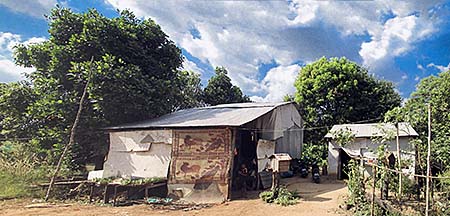
A typical dwelling in the countryside. Image by Asienreisender, 12/2015
Due to habitat loss, the wildlife in the Dangrek Mountains is meanwhile sharply declined. Only in a few remaining forested islands are still gibbons, deer, wild hog and other meanwhile rare animals living. Whatever the local people get hunted, they eat. For them, the animals of the forests are food for free.
The most important archaeological site of the mountain chain is the Preah Vihear temple, a medieval Angkorean temple on the ridge of a mountain. Another one is the much smaller site of Prasat Ta Muen, a Khmer temple site equipped with one of the 102 hospitals built in the reign of the Angkorean king Jayavarman VII. Prasat Ta Muen lies not far west of here, on territory which is under dispute and now on the Thai side of the border. It was a station on the medieval dharmasala route which led from Preah Khan near Angkor Thom to Phimai.
In the movie 'The Killing Fields' escaped Pran, the protagonist, from Democratic Kampuchea over the Dangrek Mountains into Thailand. Alltogether there were tenthousands of Cambodians trying to escape the Khmer autogenocide in the years between 1975 and 1979. 40,000 among them were forcefully repelled from the border by the Thai army and sent back to the Khmer Rouge butchers through mined territory in the Dangrek Mountain Chain. Totally exhausted, starving to death, raided by Khmer bandits, those who made it through the mountains fell easy prey to the Cambodian regime.
The Dangrek Mountains at O'Smach

The pass through the Dangrek Mountain Chain here is since ancient times a link between the low plains of Cambodia and the elevated Khorat Plateau. However, over most parts the Dangrek Mountains are low and don't extend 500m. The reason why there is still partially forest along the slopes is certainly due to the fact that the landscapes are still mined - the heritage not only of the Khmer Rouge. In the 1980s the Peoples Republic of Kampuchea laid a great deal of landmines in this area, called the 'K5-Belt', to contain the Pol Pot faction of the Khmer Rouge in their refuges in the Dangrek Mountains, particularly around nearby Anlong Veng.
Deforestation around O'Smach is advanced and human encroachment into the remaining nature is quickly processing. Here and there are some forested islands left, particularly at the steeper slopes. While the precious woods are sold to buyers abroad, other trees fall for being used as free building material or firewood. Much of what looks green and still forested on the photos are in fact orchards, cassava fields or rubber plantations. Partially, the deforested areas grow savannah-like, when not being used for any purposes.
The people here don't live with the nature. They live against it. They take as much as they can from it without considering the consequences.
The substance of the Dangrek Mountains is mostly sandstone. Here and there are the grounds sandy - sandstone declines under the tooth of erosion to sand. Probably the slopes of the Dangrek Mountain Range have once, millions of years ago, been the coastline of an ancient sea, before silt sedimentation formed the alluvial plains of Cambodia. I would say, Cambodia serves much of it's geological existence to the silt sedimentation of the Mekong River.
Images and photocomposition by Asienreisender, 12/2015
Hiking around O'Smach
It's an easy thing to have shorter hikes around O'Smach in the mountainous landscape. On both sides of the NH68 split dirt roads into the countryside. One can have a walk up to the easter side of the road and follow a track on the edge of the pass with a few good views over the sourroundings. Some of the tracks lead further east, away from the village. There are a few orchards and isolated houses in the scenic area. Southwards lies a small forest temple.
The situation looks similar at the western roadside, but I found the range one can walk rather limited than on the other side. At least, when following the tracks. One can walk also through the savannah-like stretches and climb some of the slopes; the problem is that it is not safe here because of possible land mines in the ground.
Around O'Smach, all along the stretch between the border and where the road meets the alluvial plains of Cambodia, the deforestation left only a few isolated islands of forest. Devastation and habitat loss for many species is apparent on the first glance. Now, in the dry season, are here and there fires burning, and everywhere are traces of burned bushes. Also new dirt roads are carved into the nature, soon followed by building constructions, although not in grand style. The biggest buildings here are the two casinos.
O'Smach, seen with the birds-eye view, looks like a peninsula, surrounded by three sides by Thailand. On Google maps satellite view are two lakes to see, flanking the road close to the border. The western one is a pretty one behind a larger walled area. I tried to walk through this place to make a shortcut, but after a hundred meters a guard approached me and exhausted all his foreign vocabulary: "NO!", he said, and blocked my way. Who knows what is hidden on this plot close to the border. However, I had to turn back and to surround the place to reach the lake. Surprisingly, there is no tributary to see for this water, nor a drain. At some holes at other spots I saw that the groundwater level is not deeper than 50cm below the surface.
The other, larger lake at the east side lies behind the market and bus station. One can see it from above Royal Hill Hotel & Casino, but one can not go there without being stopped by a security guard. The guard didn't explain me why he stopped me, but it seems that it was due to the border issue. On the map the lake is clearly located on the Cambodian side of the border.
At the Roadside...

Peculiar Events...
However, there are serious limitations of hiking around O'Smach, apart from the landmines. One can often simply not go where he/she wants. Alltogether I have been stopped at least six times by people, most of them didn't wear uniforms or were anyhow to recognize as authorized. Walking up a dirt road to the ridge of the mountain east of NH68, two men refused me to walk further. Turning back and using a road into another direction led me to the top of a cliff with a great view over the northernmost slopes of the Dangrek Range.
The Northern Slopes
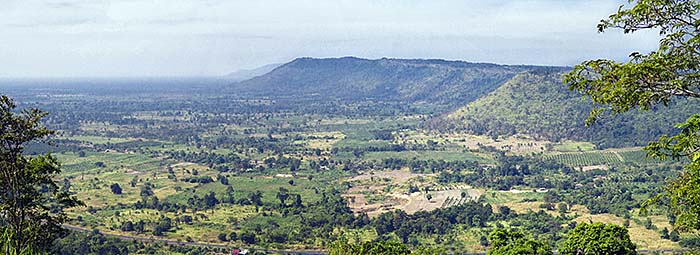
The Dangrek Mountains at O'Smach fall abruptly down into the Cambodian plain. Image by Asienreisender, 12/2015
While enjoying the great view, someone started shouting behind me. It was a very heavy soldier with a really bad face, fully clothed in battle dress. He wasn't exactly unfriendly, but didn't let me go. I talked to him, but he didn't understand any English nor Thai. There were a few wooden shacks around, and he made me understood that this was a Cambodian army camp. Peculiarly, there was no warning sign along the only road which leads to here. It seemed very much that the soldier was going to arrest me, and he wanted to search my daypack, what I didn't accept. Idiotically it has an olive green colour and looks armylike, what certainly rose his suspicion. It came with my last laptop - a wicked contribution of lenovo company to the globalized militarization, I guess.
Fortunately the soldier was practically alone, apart from a retard behind him who couldn't stop to giggle, and a woman with some kids. He didn't know how to treat me and there was no officer to make a decision. Although he didn't want to let me go I managed to leave, remaining calm and friendly, but determined. He even came after me and picked me up with his motorbike, leaving me no choice but to join him. He drove me to a neighbouring military post, but the private there didn't know what to do either. I used this opportunity to go my way and they didn't come after me anymore.
There are two explanations for the event. First, it could be easily tried banditry. Checking my belongings and taking valuables from me would have been an option. Khmers have a long, long history as thieves, robbers, bandits, pirates. Undisciplined, underpaid soldiers have to look for sources of income, as the police and the border officials do as well.
Another explanation, in combination with the first, is the Thai/Cambodian border dispute. It's periodically in the news that Thailand does not fully accept the 1907 border drawn in a (forced) treaty with the French colonial power of the time. Preah Vihear is placed in the Dangrek Mountains not too far east of here. Closely west of hier lies Prasat Ta Muen, also under dispute, under control of the Thai army now. In 2011 there were considerable fightings there and several villages were evacuated. Due to these tensions the military on both sides are quite 'nervous'.
By this background, guys who hike day for day through the landscapes and make a lot of photos and go, where people usually don't go, give a suspicious impression, so to say.
